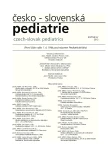GM1 gangliosidosis associated with multiple mongolian spots
Authors:
V. Urbanová 1; J. Behúnová 1; R. Petrovič 2; Ľ. Podracká 1
Authors‘ workplace:
I. Klinika detí a dorastu LF UPJŠ a DFN, Košice
prednostka prof. MUDr. Ľ. Podracká, CSc.
1; Ústav lekárskej biológie, genetiky a klinickej genetiky LFUK a UNB, Bratislava
prednosta doc. MUDr. D. Böhmer, PhD.
2
Published in:
Čes-slov Pediat 2012; 67 (4): 242-247.
Category:
Case Histories
Overview
The authors report a rare case of a 12-month old dysmorphic child with severe hypotonia, psychomotor retardation, significant hepatosplenomegaly and numerous, extensive mongolian spots. The patient presented with several congenital defects, such as critical coarctation of aorta, hypospadia and bilateral scrotal hernia. Child frequently suffered of severe bronchitis and bronchopneumonia with acute respiratory insufficiency requiring artificial ventilation.
Suspicion of gangliosidosis type I was supported by a „special“ clinical picture (extensive mongolian spots rapidly increasing in size and number, psychomotor retardation and hepatosplenomegaly) and it was confirmed by deficient activity of the lysosomal hydrolase, acid β-D-galactosidase. Moreover, abnormal urinary secretion of specific oligosaccharides was found suggesting GM1 gangliosidosis.
Key words:
GM1 gangliosidosis, mongolian spots, hepatosplenomegaly, coarctation of aorta
Sources
1. Su F, Li F, Jin H-Z. Extensive mongolian spots in a child with mucopolysacharidosis II, case report. Int J Derm 2010; 49: 438–440.
2. Leung AKC, Robson WLM. Mongolian spots and GM1 gangliosidosis type one. J Roy Soc Med 1993; 86: 120–121.
3. Weissbluth M, Esterly NB, Caro WA. Report of an infant with GM1 gangliosidosis type I and extensive and unusual mongolian spots. Br J Derm 1981; 104: 195–200.
4. Beattie RM, Harvey D. Extensive and unusual Mongolian blue spots in a child with GM1 gangliosidosis type one. J Roy Soc Med 1992; 85: 574–575.
5. Tegay DH. GM1 gangliosidosis. 2009, http://emedicine.medscape. com/article/951637-overview#showall, [citated 2012 Jan 16].
6. Brunetti-Perri N, Scaglia F. GM1 gangliosidosis: review of clinical, molecular, and therapeutic aspects. Mol Genet Metab 2008; 94 (4): 391–396.
7. Kliegman RM, Behrman RE, Jensen HB, et al. Lipidoses. In: McGovern MM, Desnick R.J. Nelson Textbook of Pediatrics. 18th ed. Philadelphia: An Imprint of Elsevier, 2007: 593–595.
8. Fernandes J, Saudubray J-M, Berghe G, et al. Diagnostika a léčba dědičných metabolických poruch. 4. vyd. Praha: Triton, 2008: 535–536.
9. Senanayake MP, Dissanayake PV, Rupasinghe S, et al. Unusually large mongolian blue spots in GM1 gangiosidosis: Is there an association? Sri Lanka Journal of Child Health 2010; 39: 117–118.
10. Silengo M, Battistoni G, Spada M. Is there a relationship between extensive mongolian spots and inborn errors of metabolism? Am J Med Genet 1999; 87: 276–277.
11. Dweikat I, Libdeh BA, Hanadi M, et al. GM1 gangliosidosis associated with neonatal-onset of siffuse ecchymoses and mongolian spots. Indian J Dermatol 2011; 56: 98–100.
12. Nyhan WL, Barshop BA, Ozand PT. Atlas of Metabolic Diseases, GM1 Gangliosidosis/β-Galactosidase Deficiency. 2nd ed. London: Hodder Arnold, 2005: 599–607.
13. Hanson M, Lupski JR, Hicks J, et al. Association of dermal melanocytosis with lysosomal storage disease. Arch Dermatol 2003; 139: 916–920.
14. Hofer D, Paul K, Fantur K, et al. Phenotype determining alleles in GM1 gangliosidosis patients bearing novel GLB1 mutations. Clinical Genetics (an international journal of genetics molecular and personalized medicine) 2010; http://onlinelibrary.wiley.com/doi/10.1111/j.1399-0004.2010.01378.x/pdf [citated 2012 Jan 25].
15. Caciotti A, German SC, Rivera-Colón Y, et al. GM1 gangliosidosis an Morquito B disease: an update on genetic alterations and clinical findings. Biochim Biophys Acta 2011; 1812 (7): 782–790.
16. Bloch LD, Matsumoto FY, Belda W Jr, et al. Dermal melanocytosis associated with GM1-gangliosidosis type 1. Acta Derm Venereol 2006; 86: 156–157.
17. Callahan JW. Pathophysiological bases of GM1 gangliosidosis and Morquito, type B: a hypothesis. Biochimica at Biophysica Acta 1999; 1455: 85-103.
18. Hoffman GF, Nyhan WL, Zschocke J, et al. Dědičné metabolické poruchy. Praha: Grada Publishing, 2006: 349–360.
19. Fantur KM, Wrodnigg TM, Stütz AE, et al. Fluorous iminoalditols act as effectie pharmacological chaperones against gene products from GLB1 alleles causing GM1-gangliosidosis and Morquio B disease. J Inherit Metab Dis 2011; [Epub ahead of print].
Labels
Neonatology Paediatrics General practitioner for children and adolescentsArticle was published in
Czech-Slovak Pediatrics

2012 Issue 4
- What Effect Can Be Expected from Limosilactobacillus reuteri in Mucositis and Peri-Implantitis?
- The Importance of Limosilactobacillus reuteri in Administration to Diabetics with Gingivitis
Most read in this issue
- Does the postnatal detection of renal pelvis dilation a higher risk of urinary tract infection?
- Total anomalous pulmonary venous return – uncommon cause of failure to thrive in infant
- GM1 gangliosidosis associated with multiple mongolian spots
- Application of ultrasonography in the diagnostics of pyelonephritis
